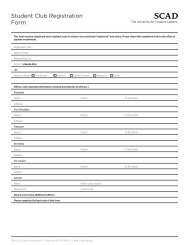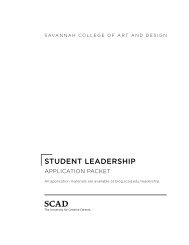Nicole Roberts MFA Thesis Visual Component Artwork - Savannah ...
Nicole Roberts MFA Thesis Visual Component Artwork - Savannah ...
Nicole Roberts MFA Thesis Visual Component Artwork - Savannah ...
Create successful ePaper yourself
Turn your PDF publications into a flip-book with our unique Google optimized e-Paper software.
visualizing curricular concepts<br />
Noteworthy schools, like Art Center College of Design in Pasadena, California, or Maryland Institute College<br />
of Art in Baltimore, Maryland require 10–20 portfolio pieces up front from applying high school seniors to<br />
assess advanced student potential. This type of evaluation often becomes circumstantial, deterring promising<br />
students who have yet to be exposed to creative studies in high school, or who do not have the means to<br />
produce a collection of portfolio pieces. Other collegiate design programs more logically accept students<br />
without a portfolio evaluation into their foundation program for fundamental ‘pre-graphic design’ studies. It<br />
is more practical for schools to assess student talent after requiring a first year of intense coursework. Only at<br />
this point should student work be pragmatically reviewed to grant or deny their continuation into the official<br />
graphic design program.<br />
When comparing the success of certain curricular concepts, another point of contention amongst<br />
professors and students is the necessity of interim and exit reviews. 67% of students polled were not required<br />
to go through any sort of provisional or final review to gauge their progress. With open admission design<br />
school policies at the beginning of a student’s educational career, and the aforementioned lack of professional<br />
certification upon graduation, it is imperative for collegiate programs to implement reviews as academic<br />
checkpoints. They act as an essential barometer to ensure the release of fully competent graduates into the<br />
professional workplace. When surveyed, educators overwhelmingly agreed. 89% advocate for mandated<br />
interim and exit reviews prior to graduation and 96% believe that undergraduates should be required to<br />
complete a comprehensive senior capstone project or thesis to summate their studies in graphic design.<br />
Lastly, a design school’s accreditation is also a vital component to evaluate when comparing curricular<br />
concepts. 73% of educators agree that a design school’s accrediting association is an important indicator of<br />
their viability, yet several design schools remain only regionally (as opposed to nationally) accredited. For<br />
higher education as a whole, it is largely disputed which type of accrediting association, regional or national,<br />
possesses more quality control over curricular components. But for graphic design specifically, the National<br />
Association of Schools of Art and Design (nasad) is the most logical choice due to the collaboration with<br />
aiga (the professional association for design). nasad showcases substantial strides to homogenize successful<br />
curricular requirements for graphic design education; for this reason, design schools are remiss should they<br />
choose not to align themselves with such initiatives.<br />
55
















